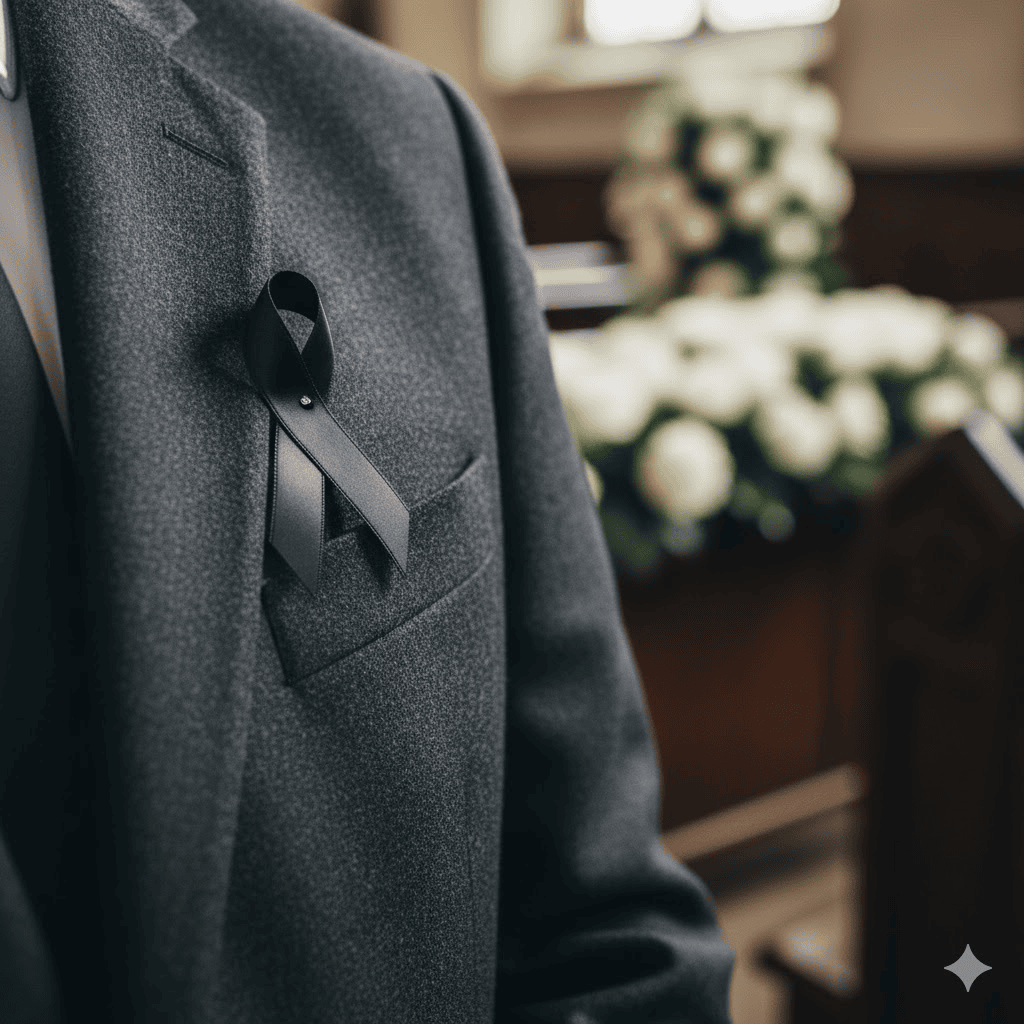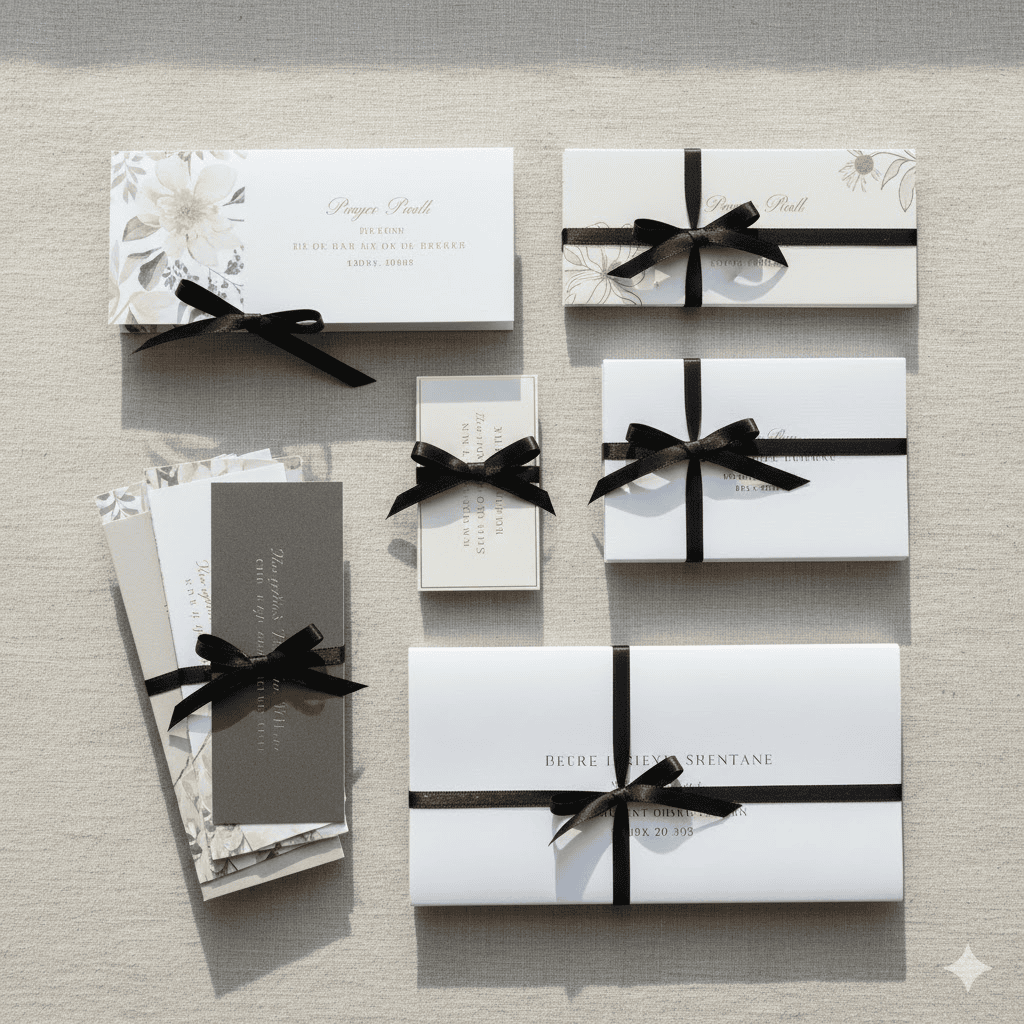Black Ribbon Meaning: Symbolism, Mourning Traditions, and Modern Memorial Uses
Short Comforting Bible Verses for The Death of a Loved One
November 6, 2025Simple symbols carry weight during grief.
A folded flag. A lit candle. A black ribbon pinned over your heart.
The black ribbon stands as one of the oldest ways people signal loss. Across cultures and centuries, mourners have worn them to show respect, mark their grief, and stand with others who understand what it means to lose someone. The tradition started centuries ago and keeps evolving, but the meaning stays constant. A visual way to say “I remember” when your voice won’t work.
This guide covers what black ribbons symbolize, where the custom comes from, and how people use them today at funerals and memorials.
What Does a Black Ribbon Symbolize?
Mourning. That’s the core meaning.
Someone died. You’re grieving. You want people to know without having to explain it twenty times a day.
The black ribbon on your chest tells coworkers, neighbors, people at the grocery store that you’re dealing with loss right now. Signals you might need a little grace. A little patience. Some space to not be okay.
Different from just wearing black clothes, which could mean anything. The ribbon is deliberate. You pinned it there on purpose. It means something specific.
Works across cultures too. Doesn’t matter what religion you practice or where you’re from. Black ribbon communicates grief universally. Someone important is gone. You’re honoring their memory. You’re asking the world to acknowledge that this person mattered.
The meaning of black ribbon for mourning holds steady whether you’re at a funeral in New York or a memorial service in Manila. Simple symbol. Deep significance.
The History and Origin of the Black Ribbon
Wearing black to signal mourning goes way back.
Early Europeans wore black armbands after a death. Men kept them on for months, sometimes a full year depending on how close they were to the deceased. Public grief. No hiding it.
Jewish tradition gave us the Kriah ribbon. During shiva (the week-long mourning period after a funeral), mourners wear a torn black ribbon pinned near their heart. Represents a torn heart. The old custom involved actually tearing your clothing. Modern practice substitutes a small ribbon with a symbolic tear cut by the rabbi.
The Victorian era took mourning to elaborate levels. Widows wore black for years. Entire wardrobes in grief colors. Black gloves, veils, jewelry made from the dead person’s hair. Mourning became performance, social obligation, and an exhausting ritual.
But underneath all that Victorian excess, the impulse was real. Mark the loss visibly. Don’t pretend everything’s fine when your world just shattered.
As society loosened those rigid rules, the black ribbon emerged as a simpler option. Pin it on for the funeral. Wear it through the hardest weeks. Take it off when you’re ready, or keep it as long as you need.
The thing is, the ribbon adapted over time. Started as actual fabric. Now you see digital black ribbons on websites during tragedies. Social media overlays. Memorial badges. Form changes but function doesn’t.
The Meaning of a Black Ribbon for Mourning and Funerals
Wearing a Black Ribbon on Clothing

Most people pin them on the left side of the chest. Over the heart.
Some wear them on their sleeve instead, especially at military funerals or official state mourning events. Placement matters less than presence. You’re signalling grief. Showing respect.
The black ribbon on clothes meaning is straightforward. Visual acknowledgment that death touched your life recently. Tells people you’re mourning without requiring conversation about it.
Public figures wear black ribbons after national tragedies. Politicians during state funerals. Athletes when a teammate dies. Teachers after losing a student. Creates visible unity. We’re all feeling this. Nobody’s alone in it.
Black Ribbon at Funerals
Family members often wear matching black ribbons at services.
Sometimes the funeral home provides them. Other times families order them specifically to hand out to guests. Everyone wearing one becomes part of the mourning community for that day.
Black ribbon at funerals works for any type of service. Traditional church funeral, celebration of life, graveside ceremony. If people gathered to honor someone who died, ribbons fit.
Families sometimes attach tiny black ribbons to funeral programs or prayer cards guests take home. Small token. Reminder of a big loss.
Cultural Interpretations of the Black Ribbon
Western Traditions
In Europe and the Americas, black ribbons mostly signal personal or family grief.
You wear one after losing someone close. Parent, spouse, child, best friend. Explains to people why you’re not quite yourself. Why you need patience right now.
Organizations use them during collective tragedy too. Schools after a student dies. Sports teams after losing a coach. Workplaces after an accident. Visual solidarity.
Jewish Customs: The Kriah Ribbon
Jewish mourning includes the practice of Kriah. Means “tearing.”
Traditionally, mourners tore their clothing at the funeral to symbolize torn hearts. Modern practice substitutes a black ribbon for the actual garment. Rabbi or funeral director cuts a small tear in the ribbon while reciting a blessing.
Mourners pin this torn ribbon to their clothing throughout shiva, the seven-day mourning period. Some continue wearing it for thirty days. Physical marker of grief. Visible to others. Reminder to yourself that you’re in sacred time.
Asian Traditions
Several Asian countries use black ribbons for national mourning.
The Philippines displays them during official mourning periods after presidents or national figures die. Citizens wear them. Buildings hang them. Collective loss acknowledged publicly.
Thailand combines black and white ribbons during royal mourning. The pairing represents respect and passage from life to death.
Less about personal grief. More about shared national or cultural loss on a larger scale.
Modern Memorial Use
Digital culture adapted the symbol for online spaces.
Websites display black ribbon graphics during tragedies. Social media users add ribbon overlays to profile pictures. Comment sections fill with ribbon emojis.
Same meaning, different medium. Still says “I’m mourning” or “I remember.”
Black Ribbon Memorial Meaning: A Modern Tribute of Remembrance
Today families get creative with how they use black ribbons to honor loved ones.
Candlelight vigils often include ribbons tied to candles or worn by participants. Creates unity among mourners gathered to remember together.
Memorial walks or charity events might distribute black ribbons to everyone attending. Shows you’re all there for the same reason. Connected by loss and love for the same person.
Remembrance cards and bookmarks sometimes feature black ribbon designs printed on them. Or actual small fabric ribbons attached. Tangible keepsake or other items for guests.
Digital memorial websites incorporate ribbon graphics into the design. Header images, corner accents, page borders. Sets the tone immediately.
The black ribbon memorial meaning extends past the funeral itself. Marks ongoing remembrance. Not just “they died” but “we still honor them. We still miss them.”
Simple ribbon. Powerful tribute.
Black Ribbon Awareness Meaning: Beyond Mourning
Black primarily means grief, but awareness campaigns adopted it too.
Melanoma and skin cancer awareness uses the black ribbon. Represents the dark, dangerous nature of these cancers. Encourages screening and sun protection.
After terrorism or mass tragedy events, black ribbons signal solidarity with victims. Not always personal loss. Shared grief for community or national trauma.
Some general mourning awareness campaigns use black ribbons to represent loss broadly. Acknowledging that grief touches everyone eventually.
These awareness uses don’t replace traditional mourning meaning. They extend it. Apply the same recognition and respect to broader causes.
Way to say “I see this pain” whether it’s your own loss or shared tragedy.
Using Black Ribbons in Memorial Design and Keepsakes
Black ribbons show up in lots of memorial materials families create.
Funeral programs often include ribbon designs. Printed borders, decorative corners, graphic elements. Or actual fabric ribbons tied to the program’s binding.

Memorial cards might feature a ribbon graphic alongside the deceased’s photo. Subtle visual reminder without being heavy-handed.
Memorial bookmarks frequently use ribbon imagery. Something people actually use that keeps the memory present.
Online tribute pages use ribbon graphics in headers or backgrounds. Sets expectation immediately about what kind of site you’re visiting.
Families personalize these elements. Add names beside the ribbon. Include dates. Incorporate favorite quotes or verses. The ribbon provides foundation, personalization makes it specific to this one irreplaceable person.
How to Choose or Create a Meaningful Black Ribbon Tribute
Physical Tributes
Use actual fabric ribbons for funerals, vigils, and memorial events.
Buy them ready-made or cut black grosgrain ribbon yourself. Pin them to clothing. Tie them to chairs at the service. Attach them to programs guests receive.
Offer as keepsakes. Something small people can take home. Pin to bulletin boards. Tuck in Bibles. Hang from rearview mirrors.
Physical ribbons create tangible connections. Real in your hand.
Digital Tributes
Display ribbon icons on social media profiles during mourning.
Add them to memorial websites or online guest books. Email signatures during the weeks after a loss. Digital invitations to services.
Works well when family and friends live far apart. Everyone participates regardless of location. Shows solidarity across distance.
Personalizing Your Tribute
Plain black ribbon works fine on its own.
But adding personal touches makes it more meaningful. Print the deceased’s name on ribbons distributed at the funeral. Include birth and death dates. Add a phrase they lived by.
Pair the ribbon with other elements. Photos. Poems. Scripture. The ribbon becomes part of a larger tribute rather than standing alone.
The Emotional and Spiritual Symbolism of the Black Ribbon
Beyond practical uses, the ribbon carries deeper weight.
Represents respect. For the deceased, for their life, for the mark they left. Wearing one says “this person mattered.”
Signals remembrance. Active choice to keep someone in mind. Not just at the funeral but weeks later when everyone else moved on.
Creates solidarity with others grieving. Visual acknowledgment you’re not alone. Other people feel it too.
For some, ribbons bring comfort. Small but visible reminder that love endures past death. That grief deserves recognition. That it’s okay to still be sad months later.
The ribbon gives permission. To mourn. To miss someone. To not be okay yet.
Simple piece of fabric. Carries profound weight.
Final Thoughts: The Lasting Power of a Black Ribbon
The black ribbon endures because it communicates something essential without words.
Respect for grief. Remembrance that doesn’t demand attention but doesn’t hide. Unity among people who understand loss from the inside.
Whether you wear one at a funeral, tie it to a memorial candle, print the symbol on keepsakes, or add it to digital tributes, you’re participating in a tradition that spans cultures and centuries.
Find ways to honor your loved one that feel right. Black ribbon offers one option. Small gesture. Big meaning.
At HonorYou, we believe every remembrance deserves a personal touch. Explore our collection of customizable memorial products designed to honor life and legacy.
